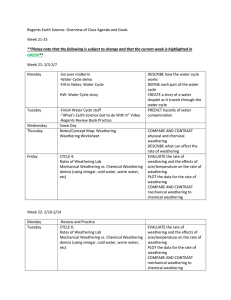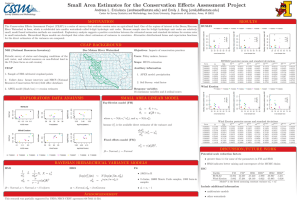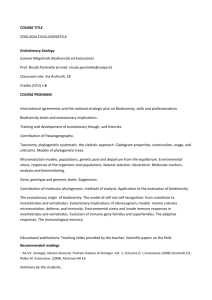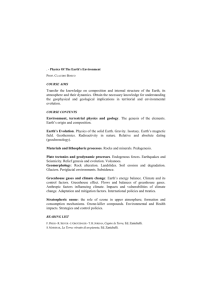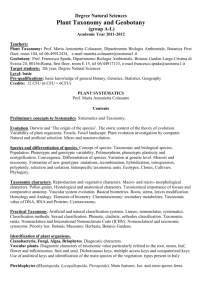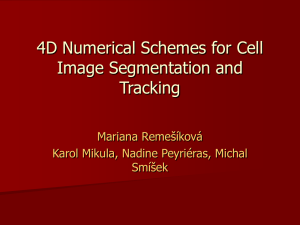Scheda tipo per le singole unità didattiche (descrittori di Dublino)
advertisement
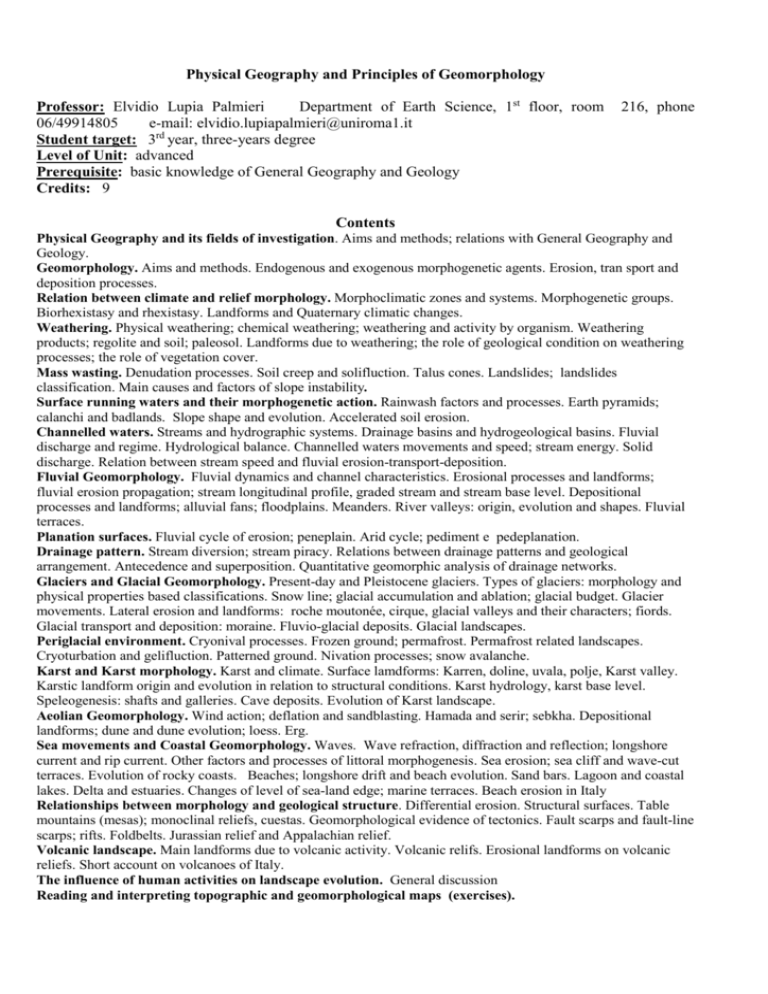
Physical Geography and Principles of Geomorphology Professor: Elvidio Lupia Palmieri Department of Earth Science, 1st floor, room 06/49914805 e-mail: elvidio.lupiapalmieri@uniroma1.it Student target: 3rd year, three-years degree Level of Unit: advanced Prerequisite: basic knowledge of General Geography and Geology Credits: 9 216, phone Contents Physical Geography and its fields of investigation. Aims and methods; relations with General Geography and Geology. Geomorphology. Aims and methods. Endogenous and exogenous morphogenetic agents. Erosion, tran sport and deposition processes. Relation between climate and relief morphology. Morphoclimatic zones and systems. Morphogenetic groups. Biorhexistasy and rhexistasy. Landforms and Quaternary climatic changes. Weathering. Physical weathering; chemical weathering; weathering and activity by organism. Weathering products; regolite and soil; paleosol. Landforms due to weathering; the role of geological condition on weathering processes; the role of vegetation cover. Mass wasting. Denudation processes. Soil creep and solifluction. Talus cones. Landslides; landslides classification. Main causes and factors of slope instability. Surface running waters and their morphogenetic action. Rainwash factors and processes. Earth pyramids; calanchi and badlands. Slope shape and evolution. Accelerated soil erosion. Channelled waters. Streams and hydrographic systems. Drainage basins and hydrogeological basins. Fluvial discharge and regime. Hydrological balance. Channelled waters movements and speed; stream energy. Solid discharge. Relation between stream speed and fluvial erosion-transport-deposition. Fluvial Geomorphology. Fluvial dynamics and channel characteristics. Erosional processes and landforms; fluvial erosion propagation; stream longitudinal profile, graded stream and stream base level. Depositional processes and landforms; alluvial fans; floodplains. Meanders. River valleys: origin, evolution and shapes. Fluvial terraces. Planation surfaces. Fluvial cycle of erosion; peneplain. Arid cycle; pediment e pedeplanation. Drainage pattern. Stream diversion; stream piracy. Relations between drainage patterns and geological arrangement. Antecedence and superposition. Quantitative geomorphic analysis of drainage networks. Glaciers and Glacial Geomorphology. Present-day and Pleistocene glaciers. Types of glaciers: morphology and physical properties based classifications. Snow line; glacial accumulation and ablation; glacial budget. Glacier movements. Lateral erosion and landforms: roche moutonée, cirque, glacial valleys and their characters; fiords. Glacial transport and deposition: moraine. Fluvio-glacial deposits. Glacial landscapes. Periglacial environment. Cryonival processes. Frozen ground; permafrost. Permafrost related landscapes. Cryoturbation and gelifluction. Patterned ground. Nivation processes; snow avalanche. Karst and Karst morphology. Karst and climate. Surface lamdforms: Karren, doline, uvala, polje, Karst valley. Karstic landform origin and evolution in relation to structural conditions. Karst hydrology, karst base level. Speleogenesis: shafts and galleries. Cave deposits. Evolution of Karst landscape. Aeolian Geomorphology. Wind action; deflation and sandblasting. Hamada and serir; sebkha. Depositional landforms; dune and dune evolution; loess. Erg. Sea movements and Coastal Geomorphology. Waves. Wave refraction, diffraction and reflection; longshore current and rip current. Other factors and processes of littoral morphogenesis. Sea erosion; sea cliff and wave-cut terraces. Evolution of rocky coasts. Beaches; longshore drift and beach evolution. Sand bars. Lagoon and coastal lakes. Delta and estuaries. Changes of level of sea-land edge; marine terraces. Beach erosion in Italy Relationships between morphology and geological structure. Differential erosion. Structural surfaces. Table mountains (mesas); monoclinal reliefs, cuestas. Geomorphological evidence of tectonics. Fault scarps and fault-line scarps; rifts. Foldbelts. Jurassian relief and Appalachian relief. Volcanic landscape. Main landforms due to volcanic activity. Volcanic relifs. Erosional landforms on volcanic reliefs. Short account on volcanoes of Italy. The influence of human activities on landscape evolution. General discussion Reading and interpreting topographic and geomorphological maps (exercises). Skills acquisition and expected learning outcomes Knowledge of the agents and mechanisms of the exogenous morphogenetic processes and of their relationships with climate and structural conditions. Knowledge of relief landforms deriving from exogenous morphogenetic processes. Skill in reconstructing the past morphological evolution of Earth relief and in predicting its future evolution Skill in reading and interpreting landforms on the basis of topographic maps examination; comprehension of the morphological evolution of relief on the basis of morphological maps interpretation. Skill in doing interpretative morphological profiles. CONTENT Hours in classroom Relations between Ex cathedra 8 climate and morphology. teaching Weathering Mass wasting. Surface running waters and their morphogenetic action. Channelled waters and fluvial Geomorphology Planation surfaces. Problems of drainage patterns. Glaciers and glacial Geomorphology Periglacial environment. Karst and karst morphology. Aeolian Geomorphology. Sea movements and coastal Geomorphology. Relations between morphology and geological structure. Volcanic landscape. The influence of human activities on landscape evolution. Reading and interpreting topographic and geomorphological maps Total Hours at home Total hours 17 25 Ex cathedra teaching 8 17 25 Ex cathedra teaching 8 17 25 Ex cathedra teaching Ex cathedra teaching Ex cathedra teaching Lezioni frontali 8 17 25 4 8,5 12,5 8 17 25 8 17 25 Ex cathedra teaching 4 8,5 12,5 Exercises 22 28 50 78 147 225 Check of results Final evaluation It will include: - a practical test about the reading and interpretation of topographic and geomorphological - an oral test to verify the knowlwdge and skills acquired by the student. Textbook CASTIGLIONI (1991). Geomorfologia. UTET, Torino. CIABATTI M. (1982). Elementi di idrologia superficiale. CLUEB, Bologna. LUPIA PALMIERI E., PAROTTO M (2008). Il globo terrestre e la sua evoluzione. Zanichelli, Bologna. 6a edizione.
